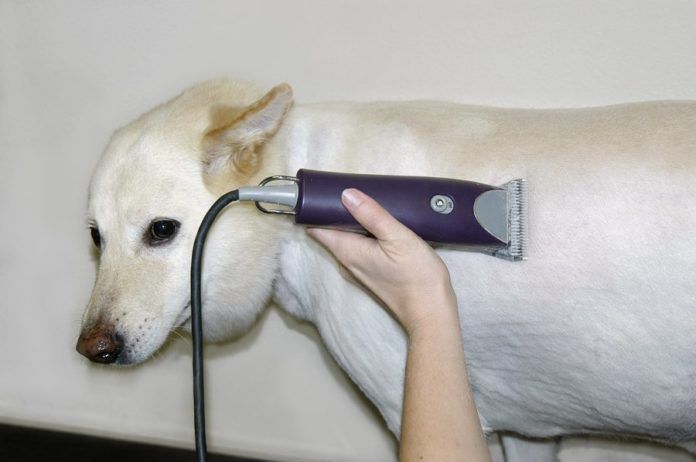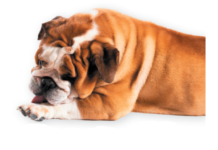Bigstock

Girls pull their hair back into ponytails; boys get buzz cuts. It helps keep them feeling fresh and cool for summer. Do dogs like to have their locks pushed or cut away in the hot summer months, too?
No, says Tufts veterinary dermatologist Lluis Ferrer, DVM, PhD, DECVD, and in general, it’s a bad idea. Hair on a dog is actually “insulating” from the heat, Dr. Ferrer comments. “The hair coat creates an air chamber between the hairs that does not conduct heat easily,” he explains. “That lack of heat conductivity serves to protect the dog’s body.
“It actually preserves body temperature in all seasons,” the doctor says. The air chamber also makes it difficult for cold air to make its way around a dog’s body in winter as well.
Other reasons not to cut hair for summer
Helping your dog stay cool is just one of several reasons to leave her hair as it is when the weather gets warm. “If you clip the hair short,” Dr. Ferrer warns, “you create the risk for sunburn, especially in dogs who are not very pigmented — those who are white or spotted. You are exposing the skin of the dog directly to UV radiation at that time of year it is strongest.”
Furthermore, Dr. Ferrer points out, hair on a dog protects from dehydration. “A dog will not lose so much water through her skin if she is well protected by her hair coat,” he says. Even in extremely hot temperatures — as high as 101 degrees Fahrenheit or more — having hair is more protective than not having it, or not having it its natural length.
“If you are really concerned about heat in the summer,” he comments, you have to deal with it by taking other measures, “like not taking your dog out for a long walk in the middle of the day, not leaving your dog in a hot car,” and so on. Short hair will certainly not protect your dog from the heavy sun in a closed-up car,” he says.
It is especially important to keep your dog out of extreme heat if she is on the larger side. “In small dogs, thermo-regulation becomes more of a problem in winter time,” he points out, “because of the ratio of their volume to their overall surface area. But for a large dog, elimination of heat becomes the more pressing issue.” That’s why, for a large dog in particular (but absolutely for all dogs), while shaving or trimming her hair won’t keep her cool and safe, keeping her in cool places and giving her plenty of fresh, cold water to drink as she pleases is critical as the sun bears down.
How you can help by tending to a dog’s hair
While you don’t want to cut or shave a dog’s hair for summer, you can make her hair coat more conducive to dealing with summertime heat by brushing her regularly. “In general, dogs with very thick or plush coats start shedding some of their hair before summer to be prepared for the heat (and then start growing it again to get ready for winter),” Dr. Ferrer says. The process starts with the hairs to be shed ceasing their growth in the follicles, he explains. But it takes a few weeks for the dead hairs to actually leave the follicles — and then the body — and “you can accelerate the shedding and appropriate, season-related thinning of the hair coat” with regular brushing, the doctor explains.
Exceptions to the no-trimming rule
While dogs in general should not get haircuts or body shaves for summer, “there are a few instances where such practices are okay,” Dr. Ferrer says. One of those instances is not about the weather but about cosmetics. He is speaking mainly of dogs with curly hair, like poodles or Portuguese water dogs. “The hair on such dogs grows constantly, all year long,” he says, so it’s okay to groom them all year round. “It’s not about summer,” he says. “It’s about whatever you do to maintain your dog’s look.”
“In some very specific cases, you will need to shave your dog for medical reasons,” Dr. Ferrer says. Some dogs “develop hot spots — localized infections because of heat and humidity on the skin — and in those instances, shaving, or even a little thinning of the hair coat with scissors, is recommended. Hot spots are more common in summertime, the doctor says, and “tend to occur more often on long-haired and plush-coated dogs. Alaskan malamutes and German shepherds, for instance, have especially plush coats because they have a topcoat and an undercoat.
“But the problem as a whole is rare,” he points out. “The vet has to have diagnosed hot spots several times before you clip for health’s sake.”
A dog with lot of matting of the hair might also need clipping, Dr. Ferrer says, because matted hair can lead to irritation of the skin or dermatitis. But this is not more likely to occur in summer. It’s a medical matter for all seasons.
The bottom line: in just about all cases, trimming or shaving a dog’s hair for summer is not a good idea. Because it’s counterintuitive, “it has become a big misconception among people,” Dr. Ferrer points out. You’ll often see dog owners get their pets’ hair shorn for the hot weather, making it an item on their to-do list. “But,” he says, “we do not recommend it.”





